Victor Gruschka Springer is Senior Scientist emeritus, Division of Fishes at the Smithsonian Institution's National Museum of Natural History in Washington, D.C. He is a specialist in the anatomy, classification, and distribution of fishes, with a special interest in tropical marine shorefishes. He has published numerous scientific studies on these subjects; also, a popular book called "Sharks in Question, the Smithsonian Answer Book" 1989.

Rhinogobius is a genus of primarily freshwater gobies native to tropical and temperate parts of eastern Asia. Most are small, streamlined in shape, and often sexually dimorphic. Few are of commercial importance, but R. duospilus is fairly widely traded as an aquarium fish.

Schismatogobius deraniyagalai, the redneck goby, is a species of goby native to India and Sri Lanka. This species inhabits river shallows, where it prefers areas with substrates that range from sand to gravel in which it can hide when threatened. This species can reach a total length of 4.5 cm (1.8 in). It can also be found in the aquarium trade. The specific name honours the Sri Lankan paleontologist and zoologist Paul E. P. Deraniyagala (1900-1976) for his contribution to the natural history of Sri Lanka.
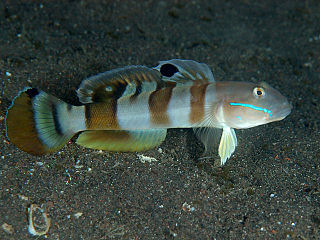
Valenciennea wardii, Ward's sleeper, Ward's sleeper goby, is a species of goby native to the Indian Ocean and the western Pacific Ocean in bays, reefs and lagoons at depths of from 12 to 35 metres. It can be found on sandy or silty substrates. This species can reach a length of 15 centimetres (5.9 in) SL. It can also be found in the aquarium trade. The specific name honours the United Kingdom diplomat Swinburne Ward (1830-1897) who was Her Majesty's Civil Commissioner for the Seychelles, although this species was described from specimens collected off Zanzibar.

Lythrypnus dalli, commonly known as the blue-banded goby or Catalina goby, is a species of goby. It is native to the eastern Pacific where it is found from Monterey Bay, California to northern Peru, including the Gulf of California. It can be found in coastal waters at depths of from 0 to 76 metres with rocky substrates in which there are crevices for concealment. It is also known to hide amongst the spines of sea urchins. It is a bidirectional hermaphrodite and capable of rapidly switching sexes. This species can reach a length of 6.4 centimetres (2.5 in) TL. It can also be found in the aquarium trade. The specific name honours the malacologist William Healey Dall (1845-1927), who when trawling for specimens off Catalina Harbour, California, caught one of the type specimens.

Koumansetta rainfordi, the old glory or Court Jester goby, is a species of goby native to tropical reefs of the western Pacific Ocean where it occurs at depths of from 2 to 30 metres. This species can reach a length of 8.5 centimetres (3.3 in) SL. It can also be found in the aquarium trade. The specific name honours the viticulturalist E. H. Rainford, of the Queensland Agricultural Department, who also collected specimens for the Australian Museum, and in 1924 he collected specimens of this species.

Hector's goby is a species of goby native to the Indian Ocean to the islands of Micronesia in the western Pacific Ocean. It can be found on sheltered coral reefs at depths of from 3 to 30 metres. This species reaches a length of 8.5 centimetres (3.3 in) SL. It can also be found in the aquarium trade. The specific name honours Gordon Hector who was Chief Secretary to the Government of the Seychelles, in gratitude for his help to Smith's work in the Seychelles.
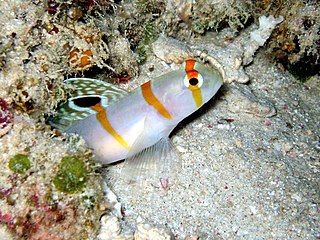
Amblyeleotris randalli, Randall's prawn goby, is a marine benthic species of goby native to tropical reefs of the central Indo-Pacific. This species can also be found in the aquarium trade.

Amblyeleotris wheeleri, the Gorgeous prawn-goby, is a species of goby native to tropical reefs of the Indian Ocean to the western Pacific Ocean. It can be found at depths of from 5 to 40 metres though is usually does not occur deeper than 15 metres (49 ft). It is a commensal with alpheid shrimps, most often being found in association with Alpheus ochrostriatus. This species can reach a length of 10 centimetres (3.9 in) SL. It can also be found in the aquarium trade.
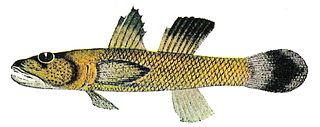
Rhinogobius carpenteri is a freshwater species of goby endemic to the Philippines. It grows up to 5.9 cm (2.3 in) SL, and is dull yellow-brown, whitish under the jaw, eyes blue, grayish fins with two silvery white anterior spines, silvery white anal fin rays, with the caudal fins shading to dusky at the tip. Its common name in the Philippines is kuchu. The species was named for the co-collector of the cotypes, Mr. W. D. Carpenter. In 1927, Albert William Christian Theodore Herre erected a new genus in the family Gobiidae, Tukugobius and moved R. carpenteri into it as the type species, but the genus was later rendered invalid.
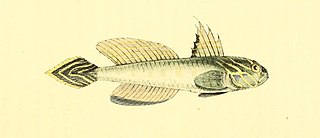
Lesueur's goby is a species of goby native to the Eastern Atlantic Ocean near the coasts of the Canary Islands and Morocco as well as in the Mediterranean Sea. This species occurs at depths down to 230 metres (750 ft) through most of its range, though the population in the Ionian Sea are found much deeper, at depths of from 322 to 337 metres. This species can reach a length of 5 centimetres (2.0 in) TL. This species can also be found in the aquarium trade The specific name honours the French naturalist Charles Alexandre Lesueur (1778-1846).
Gerald Robert "Gerry" Allen is an American-born Australian ichthyologist. His career began in 1963, when he spent a semester at the University of Hawaii, where he also received a PhD in marine zoology in 1971. In 1972, Allen wrote his doctoral thesis on the systematics and biology of the anemone fish.
Ginsburgellus novemlineatus, the Nineline goby, is a species of goby native to tropical reefs of the western Atlantic Ocean and the Caribbean Sea. It is frequently found associated with the sea urchin Echinometra lucunter, living underneath the urchin. This species grows to a length of 2.5 centimetres (0.98 in) TL. This species can also be found in the aquarium trade. This species is the only known member of its genus, the name of which honours the ichthyologist Isaac Ginsburg (1886-1975) of the U.S. National Museum who had an interest in gobies.
Rhinogobius aporus is a species in the goby subfamily Gobionellinae endemic to China. It was first described as Pseudorhinogobius aporus, but that genus has been brought into synonymy with Rhinogobius.
Paratanakia himantegus chii is a fish, a subspecies of Tanakia himantegus, that is native to Southern China mainland including Guangdong, Fujian, Jiangsu, and introduced to Taiwan.
Pseudogobiopsis lumbantobing is a species of goby from the subfamily Gobionellinae which is found in Java and Sumatra where it occurs in freshwater rivers and streams at altitudes of 5–22 metres (16–72 ft), with substrates made up of sand, gravel, rock, and boulders and where there may be growths of algae and aquatic macrophytes. This species has been traded in the European aquarium trade since 2001.

Sicydium brevifile is a species of goby from the subfamily Sicydiinae. It is an amphidromous endemic in western Cameroon and the islands of the Gulf of Guinea where the adults inhabit the clearwater streams of the volcanic islands and on the slopes of Mount Cameroon, having ascended from the sea as larvae. Specimens are imported into the Aquarium trade from Cameroon. The specific name means "short thread", Latin brevis and filum, probably a reference to the "small median papilla above the maxillary suture".

Rhinogobius niger is a small benthic species in the goby subfamily Gobionellinae endemic to Zhejiang Province, China. It was discovered in 2002 and scientifically described and assigned a binomial taxonomic name in 2016.
Rhinogobius mizunoi is a species of fish in the family Oxudercidae. It is found in a freshwater stream in Shizuoka Prefecture, Japan.
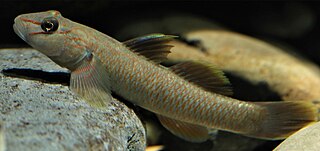
Rhinogobius candidianus is a species of freshwater goby. It is endemic to Taiwan.
Li, F. and J.-s. Zhong, 2009. Rhinogobius zhoui, a new goby (Perciformes: Gobiidae) from Guangdong Province, China. Zool. Res. 30(3):327-333.













